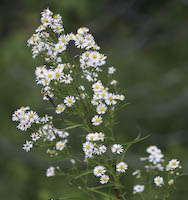Panicled Aster
Symphyotrichum lanceolatum
(formerly Aster lanceolatus) |
 Other common names:
Lance-leaved Aster, White Panicle Aster Other common names:
Lance-leaved Aster, White Panicle Aster

Other scientific names:
Aster lanceolatus, Aster hesperius, Aster paniculatus, Aster simplex

French names:
Aster simple

Family:
Composite Family (Asteraceae)

Group:
Asters

Distinctive features:
Open spreading form. Dead stem leaves very curly.

Similar species:
•
Heath Aster (Symphyotrichum ericoides)
•
Frost Aster (Symphyotrichum pilosum) - Stem very hairy, resembles frost (although there is a variety that is not hairy!).
•
Calico Aster (Symphyotrichum lateriflorum)

Flowers:
Summer, Autumn; White; 7 or more parts (petals); 1-2cm in diameter. Ray flowers: 16-47, usually white. Disc flowers: 20-40, whitish to yellowish, turning purple. Flowers spread out, not on one side of the stem.

Leaves:
Alternate, Simple, Entire; Long and narrow, lance-shaped. Dead leaves along the stem tend to be very curly, as in a spiral. Lower leaves usually gone by flowering. The biggest leaves are in the upper middle of the stem.

Height:
Up to 100 cm (39 in)

Habitat:
Forests, Fields and Open Areas, Meadows; Moist low areas, open or forested.

Grows in Sun/Shade:
Sun

Lifespan:
Perennial.

Books:
Newcomb's Wildflower Guide: 456
Peterson's Field Guide to Wildflowers: 94

Native/Non-native:
Native

Status:
Common.

Notes:
A very common Aster. Identify it by the curly dead leaves.

Origin and Meaning of Names:
Scientific Name: lanceolatus: lance-shaped

Photographs:
234 photographs available, of which 15 are featured on this page. SCROLL DOWN FOR PHOTOGRAPHS.

Range Map is at the bottom of the page
 |
 |
|
|
|
|
|
|
|
 |